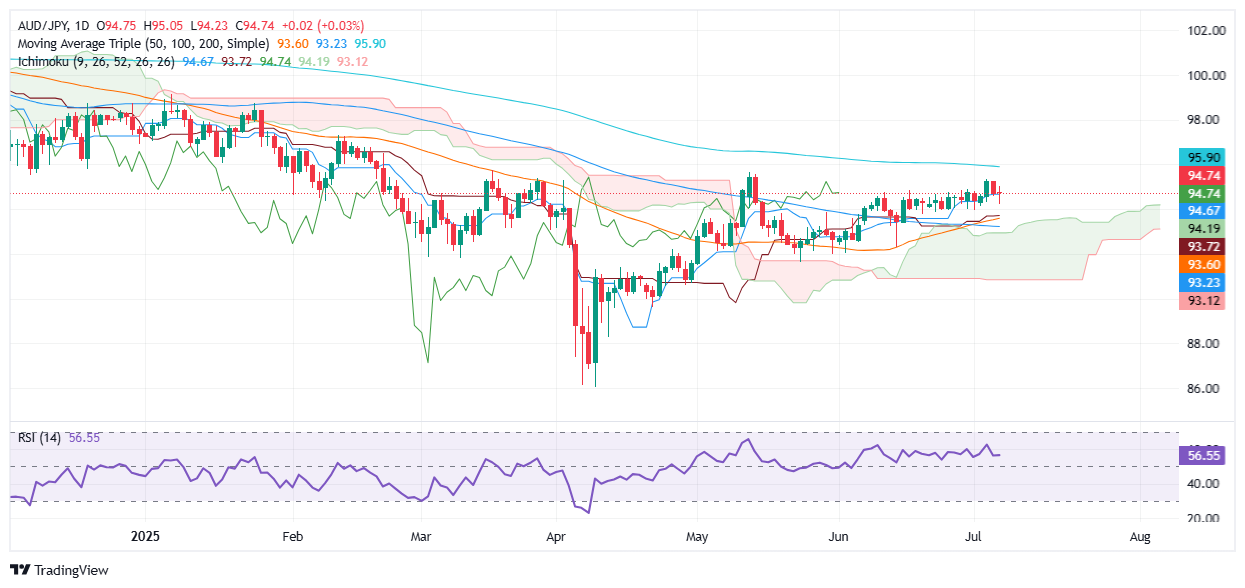AUD/JPY Price Forecast: Holds steady below 95.00 ahead of RBA decision
- AUD/JPY gains 0.17%, closing near 94.79 as tariff headlines fail to boost the Yen.
- RBA decision in focus; markets expect dovish tone amid fragile sentiment.
- Key resistance at 95.00; breakout could open door to 97.32 and 99.15.
- First support seen at 94.65 (Tenkan-sen), then 94.18 and 93.00 (Kumo top).
The AUD/JPY edged up on Monday and gained 0.17%, finishing the day near 94.79 as traders digested actions by the White House, which sent several letters to countries, setting tariffs on their imports into the US. Although it usually triggered a risk-off impulse, the Yen failed to gain traction. Traders are eyeing the Reserve Bank of Australia (RBA) monetary policy decision later on Tuesday.
AUD/JPY Price Forecast: Technical outlook
The AUD/JPY continues to consolidate, though the range is set. On the upside, a clear break above 95.00 paves the way for further upside. Key resistance levels lie on February 12 high at 97.32, followed by a January 30 high at 98.75, ahead of testing the yearly peak of 99.15
On the other hand, the first support would be the Tenkan-sen at 94.65, followed by testing the Senkou Span A at 94.18. On further weakness, the next support would be the Senkou Span B and the Kijun-sen at around 97.77/70, followed by the top of the Ichimoku Cloud (Kumo) at 93.00
AUD/JPY Price Chart – Daily

Australian Dollar FAQs
One of the most significant factors for the Australian Dollar (AUD) is the level of interest rates set by the Reserve Bank of Australia (RBA). Because Australia is a resource-rich country another key driver is the price of its biggest export, Iron Ore. The health of the Chinese economy, its largest trading partner, is a factor, as well as inflation in Australia, its growth rate and Trade Balance. Market sentiment – whether investors are taking on more risky assets (risk-on) or seeking safe-havens (risk-off) – is also a factor, with risk-on positive for AUD.
The Reserve Bank of Australia (RBA) influences the Australian Dollar (AUD) by setting the level of interest rates that Australian banks can lend to each other. This influences the level of interest rates in the economy as a whole. The main goal of the RBA is to maintain a stable inflation rate of 2-3% by adjusting interest rates up or down. Relatively high interest rates compared to other major central banks support the AUD, and the opposite for relatively low. The RBA can also use quantitative easing and tightening to influence credit conditions, with the former AUD-negative and the latter AUD-positive.
China is Australia’s largest trading partner so the health of the Chinese economy is a major influence on the value of the Australian Dollar (AUD). When the Chinese economy is doing well it purchases more raw materials, goods and services from Australia, lifting demand for the AUD, and pushing up its value. The opposite is the case when the Chinese economy is not growing as fast as expected. Positive or negative surprises in Chinese growth data, therefore, often have a direct impact on the Australian Dollar and its pairs.
Iron Ore is Australia’s largest export, accounting for $118 billion a year according to data from 2021, with China as its primary destination. The price of Iron Ore, therefore, can be a driver of the Australian Dollar. Generally, if the price of Iron Ore rises, AUD also goes up, as aggregate demand for the currency increases. The opposite is the case if the price of Iron Ore falls. Higher Iron Ore prices also tend to result in a greater likelihood of a positive Trade Balance for Australia, which is also positive of the AUD.
The Trade Balance, which is the difference between what a country earns from its exports versus what it pays for its imports, is another factor that can influence the value of the Australian Dollar. If Australia produces highly sought after exports, then its currency will gain in value purely from the surplus demand created from foreign buyers seeking to purchase its exports versus what it spends to purchase imports. Therefore, a positive net Trade Balance strengthens the AUD, with the opposite effect if the Trade Balance is negative.
